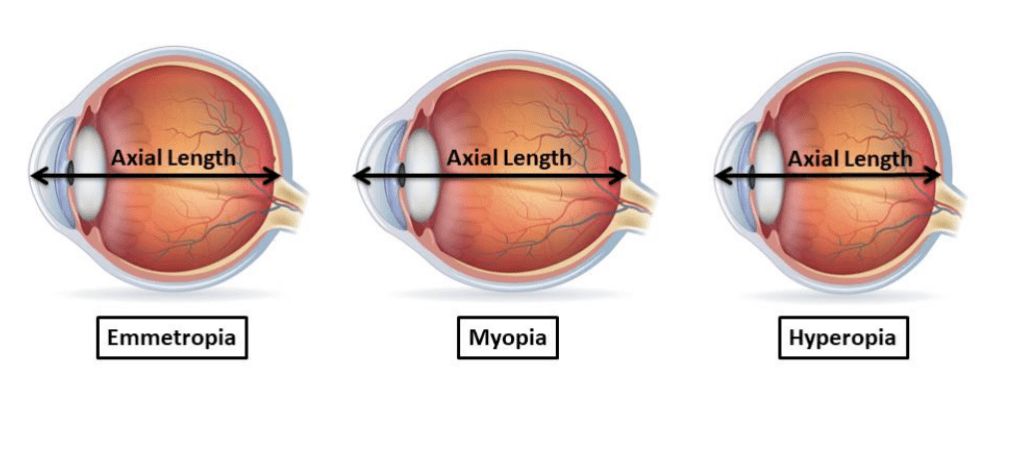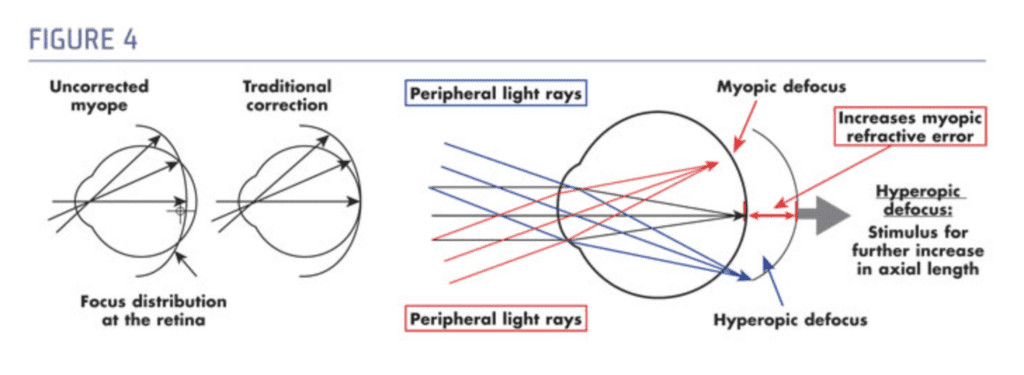Understanding Mechanisms of Myopia: Nature vs Nurture


March 16, 2023
Myopia and Nature vs Nurture: The Great Debate!
Myopia, commonly known as nearsightedness, is a refractive error that causes distant objects to appear blurry. It is a condition that affects approximately one-third of the global population, and its prevalence is expanding: global trends predict nearly 50% of the world’s population will be myopic by 2050.
There are three main types of myopia:
- Pathological Myopia
- School-Age Myopia
- Adult-Onset Myopia
School-age myopia is most common and the type we see most often in our clinic. Stabilization of school age myopia occurs between 16 and 22 years old, and studies show the timeline and extent of progression can be influenced by both genetic and environmental factors. The exact mechanisms of and interventions to slow myopia progression have been extensively investigated and are all topics still actively researched by eye experts today. So let’s dive in! It’s the great debate: what exactly causes myopia progression? Nature or nurture?
Nature
Axial Length
One of the main mechanisms of myopia is elongation of the eyeball. In a normal eye, light is focused onto the retina, the light-sensitive tissue at the back of the eye, by the cornea and the lens. In a myopic eye, the eyeball is too long, causing the light to be focused in front of the retina rather than on it. This results in a blurry image being formed on the retina, leading to nearsightedness. Mean adult values for axial length are 22-25mm (approximately 1 inch).

Abnormal Curvature of the Cornea and Lens
In a normal eye, the cornea and the lens are both curved and work together to focus light onto the retina. In a myopic eye, the cornea or the lens may be too steep or have an irregular shape, causing the light to be refracted incorrectly, resulting in a blurry image being formed on the retina. Laser vision correction, like LASIK and PRK work by altering corneal curvature.
Genetics
Over 160 gene loci have been linked to the development of myopia- some are involved in eye growth and development, and others involved in the signaling pathways that control eye growth. Patients often ask us: “If my spouse and I are both nearsighted, will my child be too?” Likely so, yes: Having one myopic parent increases the risk by threefold and two myopic parents by sixfold. Similarly, in twins, monozygotic twins have greater semblance in refractive error than dizygotic twins.
Nurture
Environmental factors such as prolonged near-work and lack of outdoor activity have also been linked to the development of myopia.
Prolonged near-work, such as reading, gaming or using electronic devices for extended periods of time, has been shown to increase the risk of myopia, due to the increased demand for the eyes to focus on near objects. During near work, peripheral hyperopic defocus, where peripheral light focuses behind the retina, is theorized to propagate eye growth (increase axial length) and expedite myopia progression.
Figure 2. Peripheral Hyperopic Defocus
In southeast Asia, the competitive education system and rigorous levels of homework require many hours of near point stress, and it’s likely no coincidence patients of Asian descent tend to have more myopic prescriptions.
Lack of outdoor activity and exposure to natural sunlight may also contribute to the development of myopia. Exposure to bright outdoor light stimulates the production of dopamine in the retina, which regulates the eyes’ growth. Without enough dopamine, the eye doesn’t know when to stop growing. Indoors, it’s too hard to get enough sunlight for that regulation process.
Conclusion
Myopia is a complex condition that is influenced by a combination of genetic and environmental factors. Elongation of the eyeball, abnormal curvature of the cornea or the lens, and genetic factors all play a role in the development of myopia. Evidence also shows prolonged near-work and lack of outdoor activity contribute to the development of myopia. Understanding of the mechanisms of myopia are paramount for the development of effective prevention and treatment.
References:
Holden BA, et al. Global Prevalence of Myopia and High Myopia and Temporal Trends from 2000 through 2050. Ophthalmology 2016; 123(5): 1036-1042.
Hou W, Norton TT, Hyman L, Gwiazda J; COMET Group. Axial Elongation in Myopic Children and its Association With Myopia Progression in the Correction of Myopia Evaluation Trial. Eye Contact Lens 2018 Jul; 44(4):248-259.
Upadhyay A, Beuerman RW. Biological Mechanisms of Atropine Control of Myopia. Eye Contact Lens. 2020;46(3):129-135
Figures:

Dr. Natasha Balani

